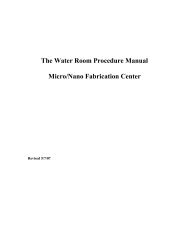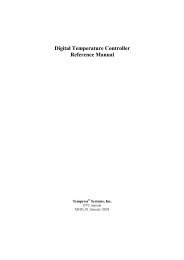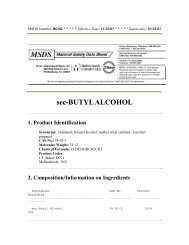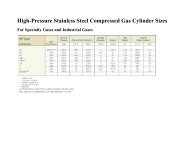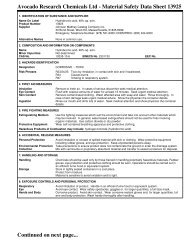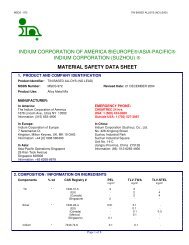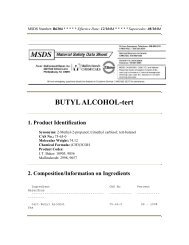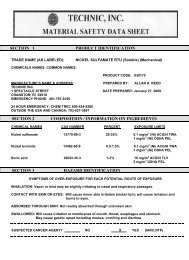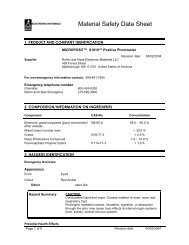Material Safety Data Sheet
Material Safety Data Sheet
Material Safety Data Sheet
You also want an ePaper? Increase the reach of your titles
YUMPU automatically turns print PDFs into web optimized ePapers that Google loves.
<strong>Material</strong> <strong>Safety</strong> <strong>Data</strong> <strong>Sheet</strong><br />
Commercial name(s).<br />
MSDS no.<br />
Product use<br />
Manufactured/supplied<br />
Nitrogen fluoride<br />
Section 1. Chemical product and company identification<br />
Address<br />
Emergency telephone<br />
number<br />
Telephone no.<br />
Prepared according to US OSHA, CMA, ANSI and Canadian WHMIS Standards.<br />
: Nitrogen fluoride<br />
20134<br />
Fluorine source for high energy lasers; dry etchant in semiconductor manufacturer;<br />
chemical intermediate.<br />
2700 Post Oak Drive<br />
Houston, TX 77056-8229<br />
CHEMTREC: 1-800-424-9300<br />
GENERAL MSDS<br />
INFORMATION<br />
1-(713)-896-2896<br />
Fax on Demand 1-(800)-231-1366<br />
Section 2. Hazards identification<br />
Physical state : Gas.<br />
OSHA/HCS status :<br />
Emergency overview : DANGER!<br />
STRONG OXIDIZER. CONTACT WITH OTHER MATERIAL MAY CAUSE FIRE. HIGH<br />
PRESSURE GAS. MAY CAUSE EYE IRRITATION. CAN CAUSE TARGET ORGAN<br />
DAMAGE. GAS REDUCES OXYGEN AVAILABLE FOR BREATHING.<br />
Routes of entry<br />
Potential acute health effects<br />
:<br />
Keep away from heat (
Section 3. Composition, Information on Ingredients<br />
Nitrogen fluoride<br />
Canada<br />
Nitrogen fluoride 7783-54-2 100<br />
United States<br />
See Sections 8, 11, 14 and 15 for details.<br />
CAS number mole %<br />
Chemical name CAS # mole % Occupational exposure limits IDLH<br />
Nitrogen fluoride 7783-54-2 100 ACGIH TLV (United States, 1/2006).<br />
STEL: 29 mg/m³ 15 minute(s). Form: All forms.<br />
TWA: 10 ppm 8 hour(s). Form: All forms.<br />
NIOSH REL (United States, 12/2001).<br />
TWA: 29 mg/m³ 10 hour(s). Form: All forms.<br />
OSHA PEL (United States, 11/2006).<br />
TWA: 29 mg/m³ 8 hour(s). Form: All forms.<br />
1000 ppm<br />
NE: Not Established C: Ceiling Limit<br />
Section 4. First aid measures<br />
Skin contact<br />
Eye contact<br />
See Section 16 for possible acronym definitions<br />
Prompt medical attention is mandatory in all cases of overexposure to this gas. Rescue personnel should wear a<br />
self-contained breathing apparatus.<br />
Inhalation<br />
: Move exposed person to fresh air. If not breathing, if breathing is irregular or if<br />
respiratory arrest occurs, provide artificial respiration or oxygen by trained personnel.<br />
Loosen tight clothing such as a collar, tie, belt or waistband. Get medical attention<br />
immediately.<br />
Ingestion<br />
Notes to physician<br />
Section 5. Fire fighting measures<br />
Flammability of the product<br />
Products of combustion<br />
Fire-fighting media and<br />
instructions<br />
Special protective<br />
equipment for fire-fighters<br />
:<br />
:<br />
:<br />
:<br />
:<br />
:<br />
:<br />
Not applicable.<br />
Immediately flush eyes with plenty of water for at least 20 minutes, occasionally lifting<br />
the upper and lower eyelids. Get medical attention.<br />
Since the product is a gas, it will probably be inhaled rather than ingested. See above.<br />
Effects of contact or inhalation may be delayed. Provide general supportive measures.<br />
Oxygen may be beneficial. The medical doctor must be warned that the person may<br />
suffer from anoxia.<br />
Non-flammable.<br />
Decomposition products may include the following materials:<br />
nitrogen oxides<br />
halogenated compounds<br />
Use an extinguishing agent suitable for the surrounding fire.<br />
Promptly isolate the scene by removing all persons from the vicinity of the incident if<br />
there is a fire. No action shall be taken involving any personal risk or without suitable<br />
training. Contact supplier immediately for specialist advice. Move containers from fire<br />
area if this can be done without risk. Use water spray to keep fire-exposed containers<br />
cool.<br />
Container explosion may occur under fire conditions or when heated.<br />
: Fire-fighters should wear appropriate protective equipment and self-contained breathing<br />
apparatus (SCBA) with a full face-piece operated in positive pressure mode.<br />
Date of issue : 12/31/2007 Page: 2/7
Section 6. Accidental release measures<br />
Personal precautions :<br />
Environmental precautions<br />
Methods for cleaning up :<br />
Section 7. Handling and storage<br />
Handling<br />
Storage<br />
Nitrogen fluoride<br />
EVACUATE ALL PERSONNEL FROM AFFECTED AREA.<br />
Use appropriate protective equipment. If leak is in user's equipment, be certain to purge<br />
piping with an inert gas prior to attempting repairs. If leak is on cylinder or cylinder valve,<br />
contact the closest Air Liquide location.<br />
: In case of a leak, clear the affected area, protect people, eliminate sources of ignition<br />
and respond with trained personnel.<br />
:<br />
:<br />
If leaking incidentally from the cylinder or its valve, contact your supplier. Use nonsparking<br />
tools and equipment during the response.<br />
Contact your local Air Liquide Gas supplier for details.<br />
Valve protection caps must remain in place unless cylinder is secured with valve outlet<br />
piped to usage point. Do not drag, slide or roll cylinders. Use a suitable hand truck for<br />
cylinder movement. Use a pressure regulator when connecting cylinder to lower<br />
pressure piping or systems. Do not heat cylinder by any means to increase the discharge<br />
rate of product from the cylinder. Use a check valve or trap in the discharge line to<br />
prevent hazardous back flow to the cylinder. Do not tamper with (valve) safety device.<br />
Close valve after each use and when empty.<br />
Protect cylinders from physical damage. Store in cool, dry, well-ventilated area of non<br />
combustible construction away from heavy traffic areas and emergency exits. Do not<br />
allow the temperature where cylinders are stored to exceed 52°C/125°F. Cylinders must<br />
be stored upright and firmly secured to prevent falling or being knocked over. Full and<br />
empty cylinders should be segregated. Prevent full cylinders being stored for excessive<br />
periods of time. Post "No Smoking or Open Flames" signs in the storage or use area.<br />
There should be no source of ignition in the storage or use area.<br />
Section 8. Exposure controls/personal protection<br />
Engineering controls<br />
Personal protection<br />
Respiratory<br />
Hands :<br />
Eyes<br />
Skin/Body<br />
:<br />
:<br />
:<br />
:<br />
Use only in well-ventilated areas. Gas is heavier than air and will therefore accumulate in<br />
low lying areas.<br />
Maintain oxygen levels above 19.5% in the workplace. Use supplied air respiratory<br />
protection if oxygen levels are below 19.5% (air purifying respirators will not function) or<br />
during emergency response to a release of this gas. During an emergency situation,<br />
before entering the area, check for oxygen-deficient atmospheres. If respiratory<br />
protection is required, follow the requirements of the Federal OSHA Respiratory<br />
Protection Standard (29 CFR 1910.134), or equivalent State standard.<br />
Respirator selection must be based on known or anticipated exposure levels, the<br />
hazards of the product and the safe working limits of the selected respirator.<br />
Wear leather gloves when handling cylinders of this gas. Otherwise, wear glove<br />
protection appropriate to the specific operation for which this gas is used.<br />
<strong>Safety</strong> glasses with side shields.<br />
Use body protection appropriate for task. Cotton clothing is recommended for use to<br />
prevent static electric build-up. Pressurized product may require use of fire retardant<br />
clothing.<br />
Metal cap, safety shoes are recommended when handling cylinders.<br />
Some applications of this product may require additionnal or other specific protective clothings. Please consult<br />
your supervisor.<br />
Date of issue : 12/31/2007 Page: 3/7
Personal protection in case<br />
of a major leak<br />
:<br />
Product name Exposure limits<br />
Canada<br />
Nitrogen fluoride ACGIH TLV (United States, 1/2006).<br />
STEL: 29 mg/m³ 15 minute(s). Form: All forms.<br />
TWA: 10 ppm 8 hour(s). Form: All forms.<br />
United States<br />
Nitrogen fluoride ACGIH TLV (United States, 1/2006).<br />
STEL: 29 mg/m³ 15 minute(s). Form: All forms.<br />
TWA: 10 ppm 8 hour(s). Form: All forms.<br />
NIOSH REL (United States, 12/2001).<br />
TWA: 29 mg/m³ 10 hour(s). Form: All forms.<br />
OSHA PEL (United States, 11/2006).<br />
TWA: 29 mg/m³ 8 hour(s). Form: All forms.<br />
NE: Not Established<br />
Nitrogen fluoride<br />
<strong>Safety</strong> glasses with side shields, goggles or face shield. Impervious gloves. Protective<br />
clothing. Metal cap, safety shoes. Wear MSHA/NIOSH-approved self-contained<br />
breathing apparatus or equivalent and full protective gear.<br />
Section 9. Physical and chemical properties<br />
Physical state<br />
Color<br />
Odor<br />
Molecular weight<br />
Molecular formula<br />
Boiling/condensation point<br />
Melting/freezing point<br />
:<br />
:<br />
:<br />
:<br />
:<br />
:<br />
:<br />
Gas.<br />
Colorless.<br />
Odorless.<br />
71.01 g/mole<br />
NF3<br />
-128.88°C (-200°F)<br />
-206.66°C (-340°F)<br />
Section 10. Stability and reactivity<br />
Stability and reactivity<br />
Hazardous decomposition<br />
products<br />
Hazardous polymerization<br />
The product is stable.<br />
Section 11. Toxicological information<br />
Toxicity data<br />
IDLH : 1000 ppm<br />
Acute Effects<br />
Eyes : Mildly irritating to the eyes.<br />
:<br />
:<br />
:<br />
Under normal conditions of storage and use, hazardous decomposition products should<br />
not be produced.<br />
Under normal conditions of storage and use, hazardous polymerization will not occur.<br />
Inhalation : High level of exposure can interfere with the ability of the blood to carry oxygen, causing<br />
headache, fatigue, dizziness and a blue color to the skin and lips (methemoglobinemia).<br />
Higher levels of exposure can cause trouble breathing, collapse and even death.<br />
Skin : No known significant effects or critical hazards.<br />
Ingestion : Since the product is a gas, it will probably be inhaled rather than ingested. See above.<br />
Potential chronic health<br />
effects<br />
: Carcinogenic effects: Not classified or listed by IARC, NTP, OSHA, EU and ACGIH.<br />
Mutagenic effects: Not available.<br />
Teratogenic effects: Not available.<br />
Target organs : Causes damage to the following organs: blood, kidneys, liver, upper respiratory tract,<br />
skin, eye, lens or cornea.<br />
Date of issue : 12/31/2007 Page: 4/7
Section 12. Ecological information<br />
Products of degradation :<br />
Disposal<br />
These gases are released as is in the atmosphere.<br />
Section 13. Disposal considerations<br />
14 .<br />
Transport information<br />
AERG : 122<br />
Regulatory<br />
information<br />
UN / IMDG / IATA<br />
Classification<br />
DOT Classification<br />
Nitrogen fluoride<br />
: Residual materials contained in customer-owned cylinders should be disposed of in<br />
accordance with Federal, State and Local regulations on waste management. For<br />
residual materials contained in cylinders owned by Air Liquide, contact Sales or<br />
Customer Service to determine appropriate disposal. Do not return cylinders without<br />
authorization from Air Liquide.<br />
NITROGEN TRIFLUORIDE, COMPRESSED 2.2, (5.1) UN2451 -<br />
TDG Classification NITROGEN TRIFLUORIDE, COMPRESSED 2.2, (5.1) UN2451 -<br />
Additional<br />
information<br />
Proper shipping name Class UN number PG Label<br />
NITROGEN TRIFLUORIDE, COMPRESSED 2.2, (5.1) UN2451 -<br />
UN IMDG<br />
IATA<br />
DOT TDG<br />
-<br />
-<br />
Passenger and Cargo Limited quantity<br />
AircraftQuantity limitation:<br />
75 kg<br />
Yes.<br />
Cargo Aircraft Only Packaging instruction<br />
Quantity limitation: 150 kg Passenger aircraft<br />
Quantity limitation: 75 kg<br />
Cargo aircraft<br />
Quantity limitation: 150<br />
kg<br />
NON - FLAMMABLE GAS<br />
OXIDIZER<br />
5.1<br />
5.1<br />
5.1<br />
2<br />
2<br />
2<br />
Special provisions<br />
38<br />
Cylinders should be transported in a secure position, in a well ventilated vehicle. The transportation of compressed gas<br />
cylinders in automobiles or in closed-body vehicles can present serious safety hazards and should be discouraged.<br />
Date of issue : 12/31/2007 Page: 5/7
Section 15. Regulatory information<br />
Canada<br />
WHMIS (Canada) : Class A: Compressed gas.<br />
Class C: Oxidizing material.<br />
United States<br />
OSHA HAZARD COMMUNICATION STANDARD (29CFR PART 1910.1200).<br />
Compressed gas<br />
Oxidizing material<br />
Irritating material<br />
Target organ effects<br />
SARA 302/304 emergency planning and notification: No products were found.<br />
Nitrogen fluoride<br />
SARA 311/312 MSDS distribution - chemical inventory - hazard identification: Nitrogen trifluoride: Fire hazard,<br />
Sudden release of pressure, Immediate (acute) health hazard<br />
CERCLA: Hazardous substances.: No products were found.<br />
US INVENTORY (TSCA)<br />
TSCA 8(b) inventory: All components listed.<br />
State regulations<br />
California prop. 65: No products were found.<br />
Canada inventory: This material is listed or exempted.<br />
CEPA DSL: All components listed.<br />
Connecticut Carcinogen Reporting: This material is not listed.<br />
Connecticut Hazardous <strong>Material</strong> Survey: This material is not listed.<br />
Florida substances: This material is not listed.<br />
Illinois Chemical <strong>Safety</strong> Act: This material is not listed.<br />
Illinois Toxic Substances Disclosure to Employee Act: This material is not listed.<br />
Louisiana Reporting: This material is not listed.<br />
Louisiana Spill: This material is not listed.<br />
Massachusetts Spill: This material is not listed.<br />
Massachusetts Substances: This material is listed.<br />
Michigan Critical <strong>Material</strong>: This material is not listed.<br />
Minnesota Hazardous Substances: This material is not listed.<br />
New Jersey Hazardous Substances: This material is listed.<br />
New Jersey Spill: This material is not listed.<br />
New Jersey Toxic Catastrophe Prevention Act: This material is not listed.<br />
New York Acutely Hazardous Substances: This material is not listed.<br />
New York Toxic Chemical Release Reporting: This material is not listed.<br />
Pennsylvania RTK Hazardous Substances: This material is listed.<br />
Rhode Island Hazardous Substances: This material is not listed.<br />
Section 16. Other information<br />
Hazardous <strong>Material</strong><br />
Information System (U.S.A.)<br />
National Fire Protection<br />
Association (U.S.A.)<br />
:<br />
:<br />
Health<br />
Fire hazard<br />
Reactivity<br />
Personal protection<br />
Health<br />
1<br />
0<br />
1<br />
*<br />
Flammability<br />
Instability<br />
Special<br />
Date of issue : 12/31/2007 Page: 6/7<br />
1<br />
0<br />
1<br />
G
Nitrogen fluoride<br />
Consult an Industrial Hygienist or other trained person when you make your safety evaluation of the end product.<br />
Remember, gases and liquids have properties which can cause serious injury or death.<br />
Further information about gas mixtures can be found in pamphlets published by: Compressed Gas Association Inc (CGA),<br />
4221 Walney Road, 5th floor, Chantilly, VA 20151-2923 Telephone: (703) 788-2700.<br />
Acronyms : ACGIH: American Conference of Governmental Industrial Hygiene.<br />
IARC: International Agency for Research on Cancer.<br />
NIOSH: National Institute of Occupational <strong>Safety</strong> and Health.<br />
OSHA: Occupational <strong>Safety</strong> and Health Administration<br />
NTP: National Toxicology program.<br />
OECD: Organisation for Economic Co-operation and Development.<br />
PEL: Permissible Exposure Limit.<br />
IDLH: Immediately Dangerous to Life and Health.<br />
NE: Not established.<br />
C: Ceiling Limit.<br />
DSL: Domestic Substance List.<br />
NDSL: Non-Domestic Substance List.<br />
CFR: Code of Federal Regulations.<br />
TSCA: Toxic Substance Control Act.<br />
Date of issue : 12/31/2007<br />
Date of previous issue : 08/01/2007<br />
Version : 4.1<br />
Notice to reader<br />
This <strong>Material</strong> <strong>Safety</strong> <strong>Data</strong> <strong>Sheet</strong> is offered pursuant to OSHA’s Hazard Communication Standard, 29 CFR,<br />
1910.1200, American National Standard Institute Z400.1, 2004, the Canadian Workplace Hazardous <strong>Material</strong><br />
Information Systems (WHMIS). Other government regulations must be reviewed for applicability to this gas<br />
mixture. To the best of Air Liquide’s knowledge, the information contained herein is reliable and accurate as of<br />
this date; however, accuracy, suitability or completeness are not guaranteed and no warranties of any type, either<br />
express or implied, are provided. The information contained herein relates only to this specific product. If this<br />
gas mixture is combined with other materials, all component properties must be considered. <strong>Data</strong> may be<br />
changed from time to time. Be sure to consult the latest edition.<br />
Date of issue : 12/31/2007 Page: 7/7



